Volker Hohmann
Neural Speech Tracking in a Virtual Acoustic Environment: Audio-Visual Benefit for Unscripted Continuous Speech
Jan 14, 2025Abstract:The audio visual benefit in speech perception, where congruent visual input enhances auditory processing, is well documented across age groups, particularly in challenging listening conditions and among individuals with varying hearing abilities. However, most studies rely on highly controlled laboratory environments with scripted stimuli. Here, we examine the audio visual benefit using unscripted, natural speech from untrained speakers within a virtual acoustic environment. Using electroencephalography (EEG) and cortical speech tracking, we assessed neural responses across audio visual, audio only, visual only, and masked lip conditions to isolate the role of lip movements. Additionally, we analysed individual differences in acoustic and visual features of the speakers, including pitch, jitter, and lip openness, to explore their influence on the audio visual speech tracking benefit. Results showed a significant audio visual enhancement in speech tracking with background noise, with the masked lip condition performing similarly to the audio-only condition, emphasizing the importance of lip movements in adverse listening situations. Our findings reveal the feasibility of cortical speech tracking with naturalistic stimuli and underscore the impact of individual speaker characteristics on audio-visual integration in real world listening contexts.
The future of hearing aid technology
Apr 27, 2023Abstract:Background. Hearing aid technology has proven successful in the rehabilitation of hearing loss, but its performance is still limited in difficult everyday conditions characterized by noise and reverberation. Objectives. Introduction to the current state of hearing aid technology and presentation of the current state of research and future development. Methods. Current literature is analyzed and several specific new developments are presented. Results. Both objective and subjective data from empirical studies show the limitation of current technology. Examples of current research show the potential of machine-learning based algorithms and multi-modal signal processing for improving speech processing and perception, of using virtual reality for improving hearing device fitting and of mobile health technology for improving hearing-health services. Conclusions. Hearing device technology will remain a key factor in the rehabilitation of hearing impairment. New technology such as machine learning, and multi-modal signal processing, virtual reality and mobile health technology will improve speech enhancement, individual fitting and communication training.
Vehicle Noise: Comparison of Loudness Ratings in the Field and the Laboratory
Apr 28, 2022
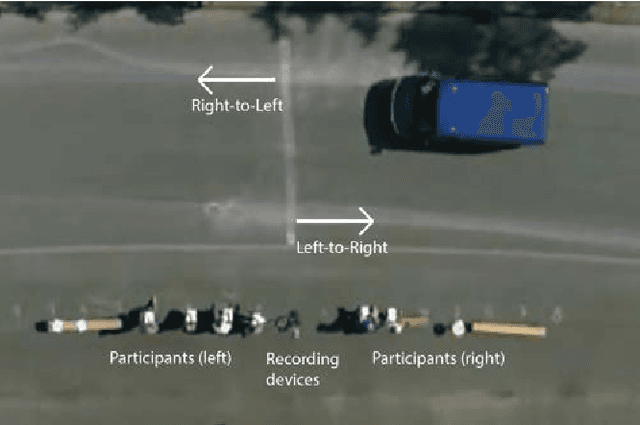
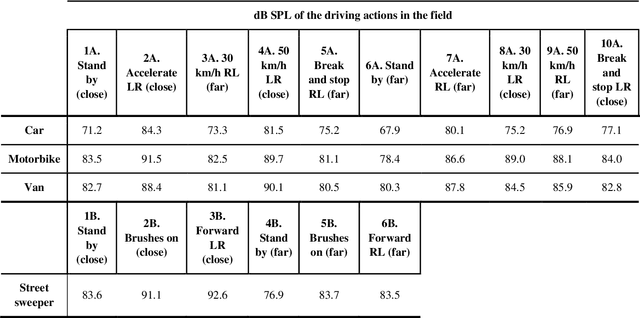
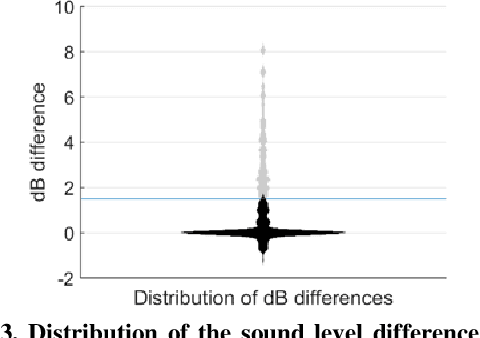
Abstract:Objective: Distorted loudness perception is one of the main complaints of hearing aid users. Being able to measure loudness perception correctly in the clinic is essential for fitting hearing aids. For this, experiments in the clinic should be able to reflect and capture loudness perception as in everyday-life situations. Little research has been done comparing loudness perception in the field and in the laboratory. Design: Participants rated the loudness in the field and in the laboratory of 36 driving actions done by four different vehicles. The field measurements were done in a restricted street and recorded with a 360deg camera and a tetrahedral microphone. The recorded stimuli, which are openly accessible, were presented in three different conditions in the laboratory: 360deg video recordings with a head-mounted display, video recordings with a desktop monitor, and audio-only. Sample: Thirteen normal-hearing participants and 18 hearing-impaired participants participated in the study. Results: The driving actions were rated significantly louder in the laboratory than in the field for the audio-only condition. These loudness rating differences were bigger for louder sounds in two laboratory conditions, i.e., the higher the sound level of a driving action was the more likely it was to be rated louder in the laboratory. There were no significant differences in the loudness ratings between the three laboratory conditions and between groups. Conclusions: The results of this experiment further remark the importance of increasing the realism and immersion when measuring loudness in the clinic.
The Period-Modulated Harmonic Locked Loop : A low-effort algorithm for rapid time-domain periodicity estimation
Jul 14, 2021
Abstract:Many speech and music analysis and processing schemes rely on an estimate of the fundamental frequency f0 of periodic signal components. Most established schemes apply rather unspecific signal models such as sinusoidal models to the estimation problem, which may limit time resolution and estimation accuracy. This study proposes a novel time-domain locked-loop algorithm with low computational effort and low memory footprint for f0 estimation. The loop control signal is directly derived from the input time signal, using a harmonic signal model. Theoretically, this allows for a noise-robust and rapid f0 estimation for periodic signals of arbitrary waveform, and without the requirement of a prior frequency analysis. Several simulations with short signals employing different types of periodicity and with added wide-band noise were performed to demonstrate and evaluate the basic properties of the proposed algorithm. Depending on the Signal-to-Noise Ratio (SNR), the estimator was found to converge within 3-4 signal repetitions, even at SNR close to or below 0dB. Furthermore, it was found to follow fundamental frequency sweeps with a delay of less than one period and to track all tones of a three-tone musical chord signal simultaneously. Quasi-periodic sounds with shifted harmonics as well as signals with stochastic periodicity were robustly tracked. Mean and standard deviation of the estimation error, i.e., the difference between true and estimated f0, were at or below 1 Hz in most cases. The results suggest that the proposed algorithm may be applicable to low-delay speech and music analysis and processing.
Open community platform for hearing aid algorithm research: open Master Hearing Aid (openMHA)
Mar 03, 2021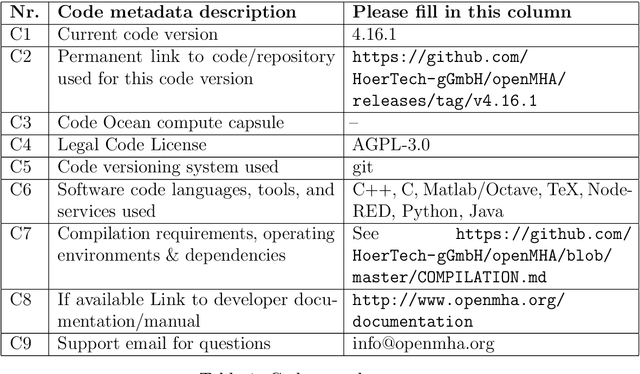
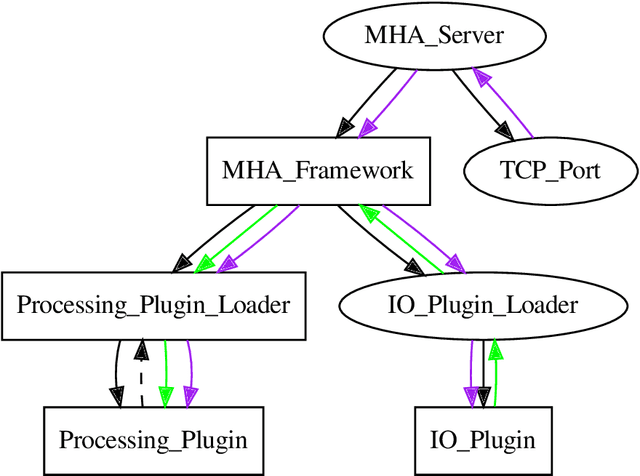

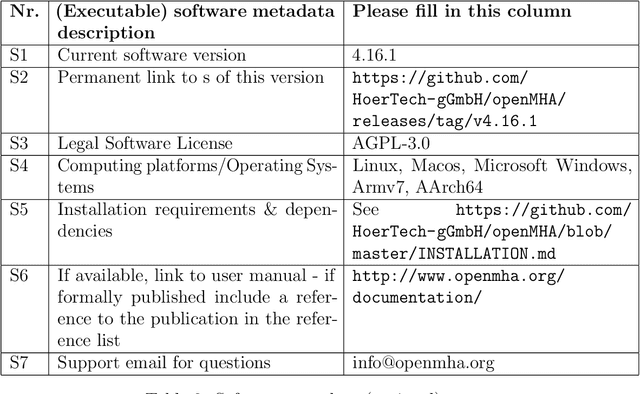
Abstract:open Master Hearing Aid (openMHA) was developed and provided to the hearing aid research community as an open-source software platform with the aim to support sustainable and reproducible research towards improvement and new types of assistive hearing systems not limited by proprietary software. The software offers a flexible framework that allows the users to conduct hearing aid research using tools and a number of signal processing plugins provided with the software as well as the implementation of own methods. The openMHA software is independent of a specific hardware and supports Linux, MacOS and Windows operating systems as well as 32- bit and 64-bit ARM-based architectures such as used in small portable integrated systems. www.openmha.org
 Add to Chrome
Add to Chrome Add to Firefox
Add to Firefox Add to Edge
Add to Edge